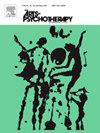“把握空间”:为青春期前战争撤离者提供的艺术治疗开放工作室,作为分析的第三
IF 1.5
3区 心理学
Q3 PSYCHOLOGY, CLINICAL
引用次数: 0
摘要
在本文中,六位艺术治疗师利用以艺术为基础的焦点小组来探讨他们在大规模创伤背景下促进开放工作室的经验。在这种情况下,开放工作室的成立是为了为青春期前的战争撤离者提供一个非指导性的艺术创作治疗空间。首先,文献综述的重点是相互认知的概念和分析的第三,以及它们与共享创伤处理的开放工作室模型的相关性。其次,使用解释性现象学分析和视觉分析作为多模态方法(Boden et al., 2019),呈现了主题分析的治疗师的艺术反应和口头反思。这一发现突出了参与者和治疗师共同的群体经历。挑战和优势来自于在持续和共同的战争创伤现实中工作,正如艺术治疗师作为团队成员所扮演的角色一样。在公共空间中进行艺术创作和目睹艺术创作似乎支持了分析性第三的出现,在这种空间中,尽管有背景和环境,但仍有多种机会进行深刻的相互认可、自我探索和联系。本文章由计算机程序翻译,如有差异,请以英文原文为准。
"Holding the Space": An art therapy open studio for preadolescent war evacuees as an analytic third
In this paper, six art therapists utilize an art-based focus group to explore their experience of facilitating an Open Studio in the context of mass trauma. The Open Studio, in this case, was formed to serve as a non-directive art-making healing space for preadolescent war evacuees. First, the literature review focuses on the conceptualizations of mutual recognition and the analytic third and their relevance to the Open Studio model for shared trauma processing. Second, using interpretative phenomenological analysis and visual analysis as the multimodal approach (Boden et al., 2019), the therapists' art responses and verbal reflections that were thematically analyzed are presented. The finding highlighted the shared group experiences for both the participants and therapists. Challenges and advantages arose from working within an ongoing and shared traumatic reality of war, as did the art therapists’ role when operating as members of a team. Art making and witnessing art made within a communal space appeared to support the emergence of the analytic third, in which multiple opportunities for profound mutual recognition, self-exploration, and connections played out despite and because of the context and setting.
求助全文
通过发布文献求助,成功后即可免费获取论文全文。
去求助
来源期刊

Arts in Psychotherapy
Multiple-
CiteScore
3.20
自引率
11.10%
发文量
66
期刊介绍:
The Arts in Psychotherapy is a dynamic, contemporary journal publishing evidence-based research, expert opinion, theoretical positions, and case material on a wide range of topics intersecting the fields of mental health and creative arts therapies. It is an international peer-reviewed journal publishing 5 issues annually. Papers are welcomed from researchers and practitioners in the fields of art, dance/movement, drama, music, and poetry psychotherapy, as well as expressive and creative arts therapy, neuroscience, psychiatry, education, allied health, and psychology that aim to engage high level theoretical concepts with the rigor of professional practice. The journal welcomes contributions that present new and emergent knowledge about the role of the arts in healthcare, and engage a critical discourse relevant to an international readership that can inform the development of new services and the refinement of existing policies and practices. There is no restriction on research methods and review papers are welcome. From time to time the journal publishes special issues on topics warranting a distinctive focus relevant to the stated goals and scope of the publication.
 求助内容:
求助内容: 应助结果提醒方式:
应助结果提醒方式:


